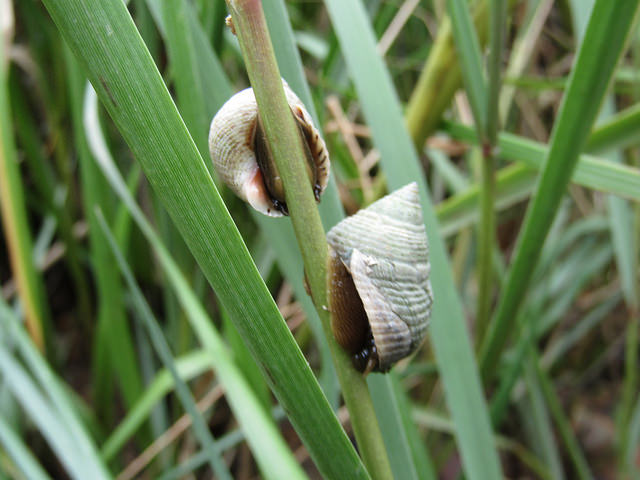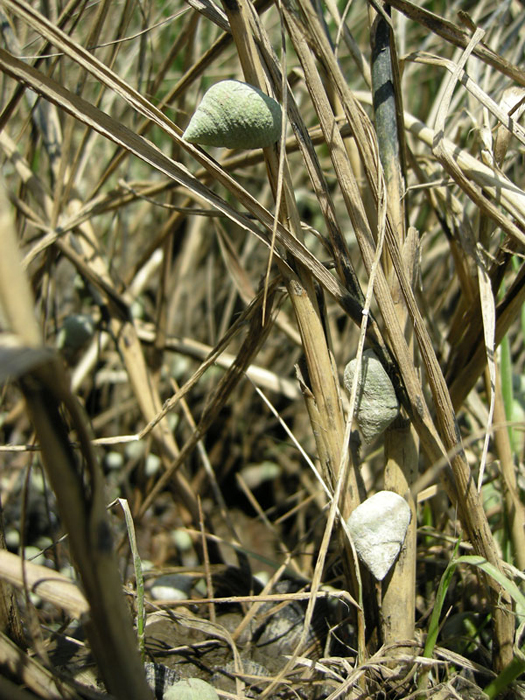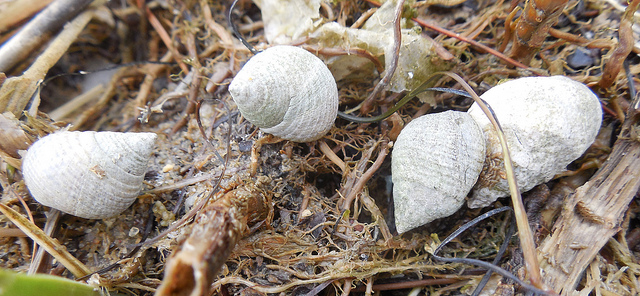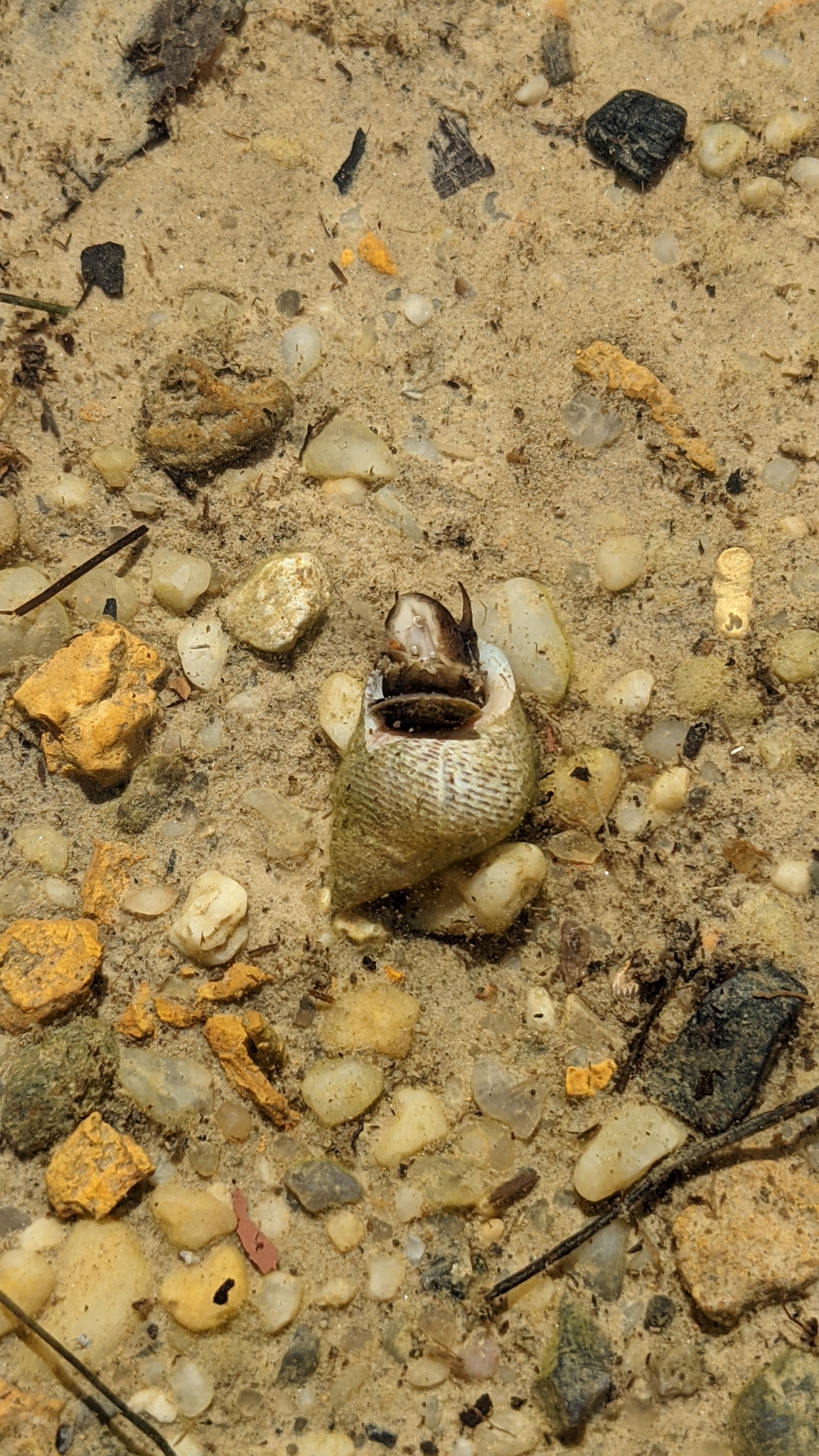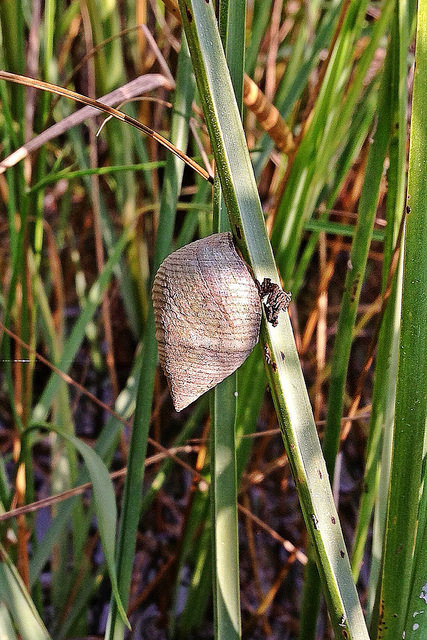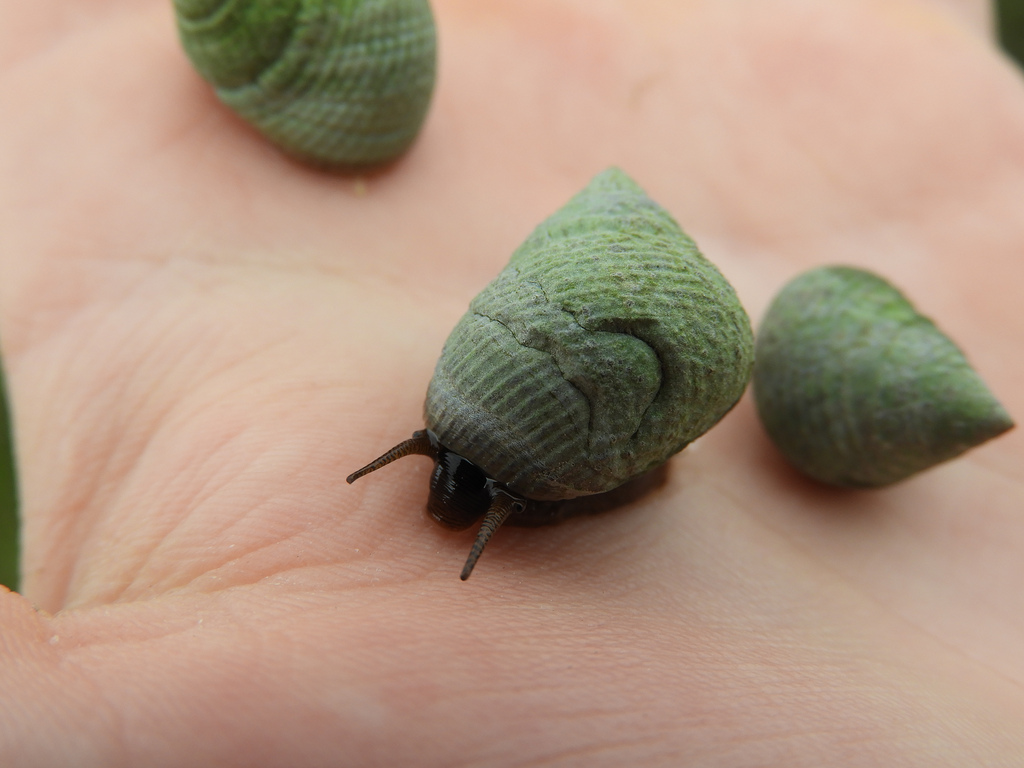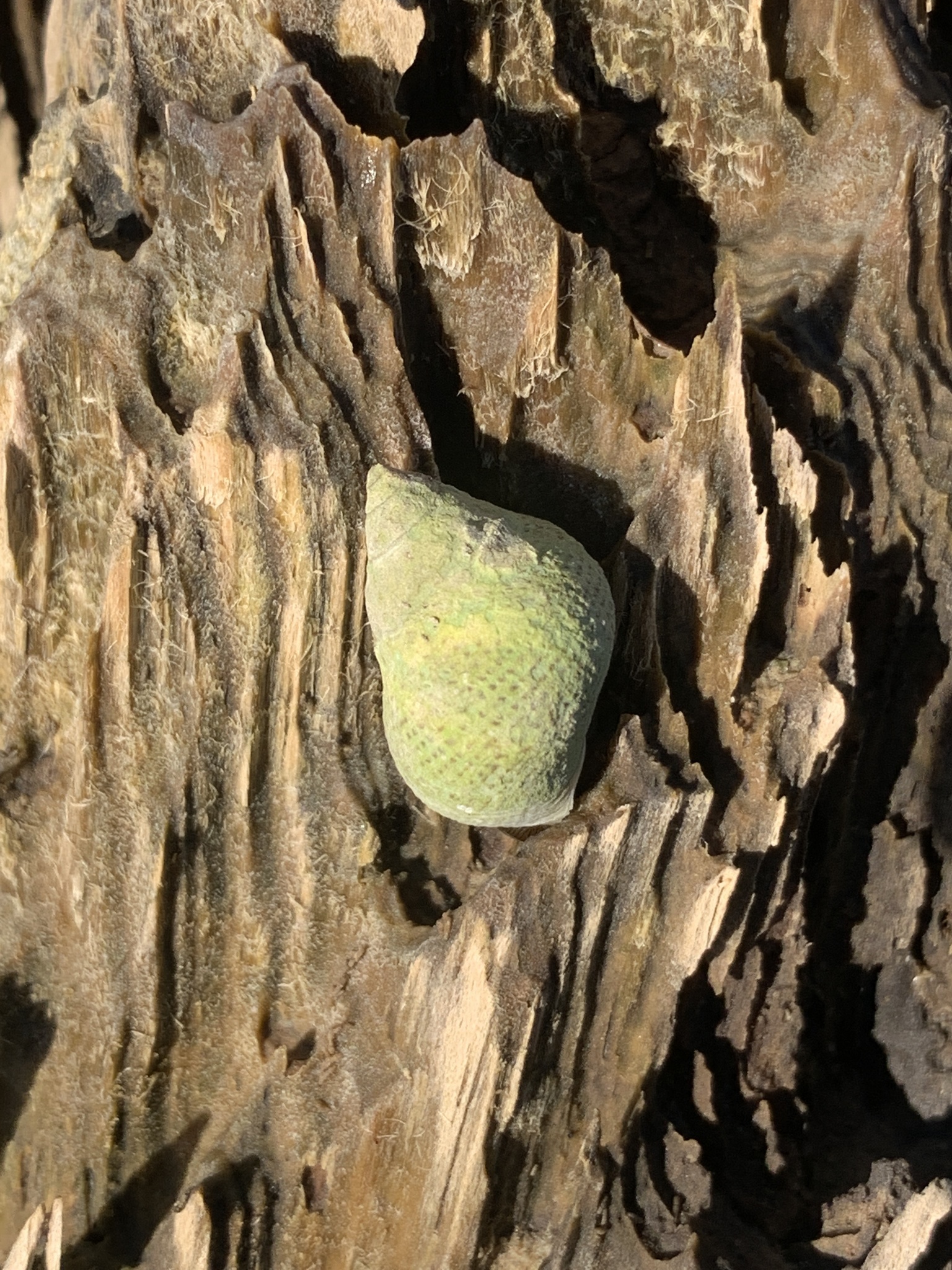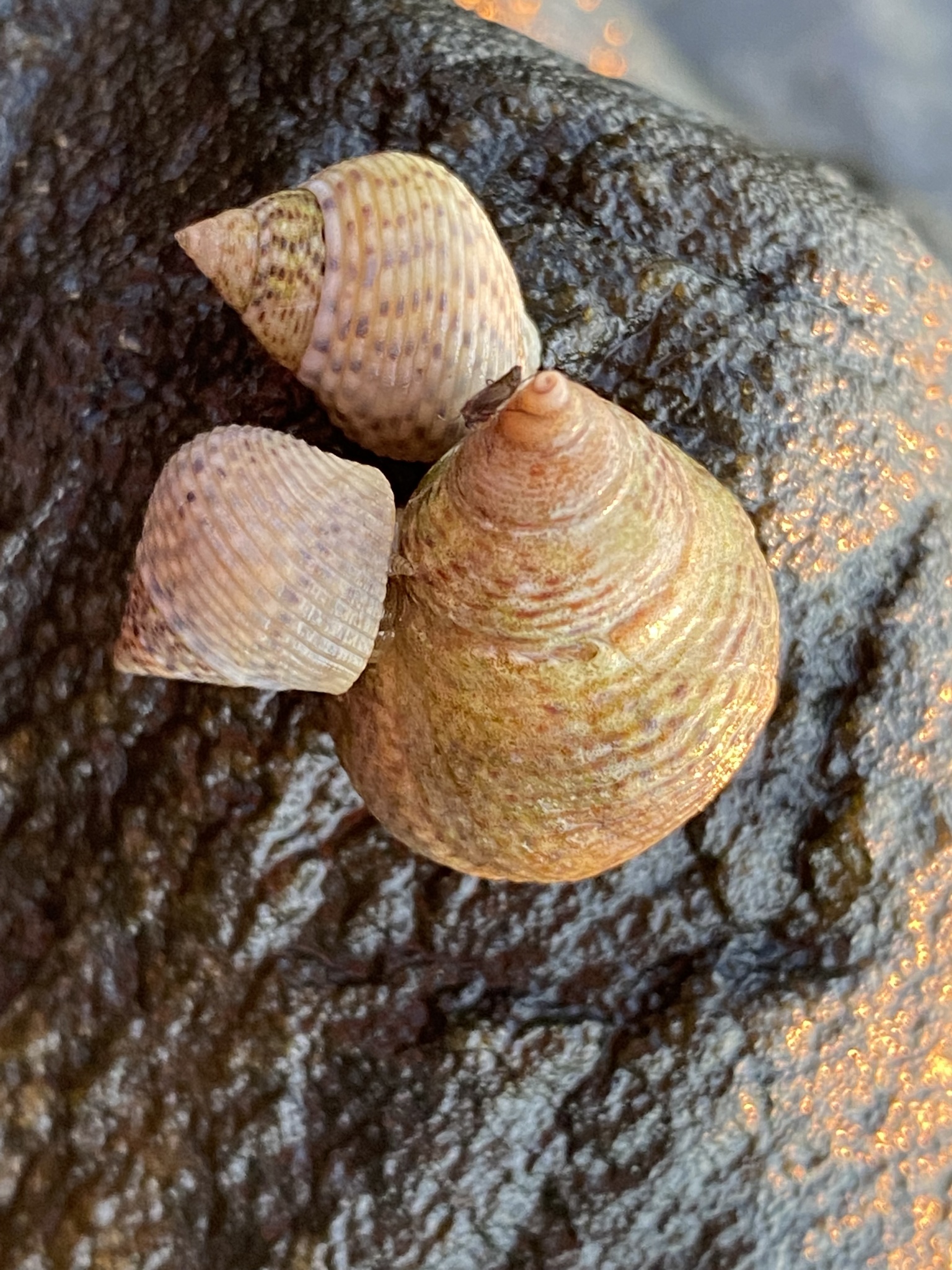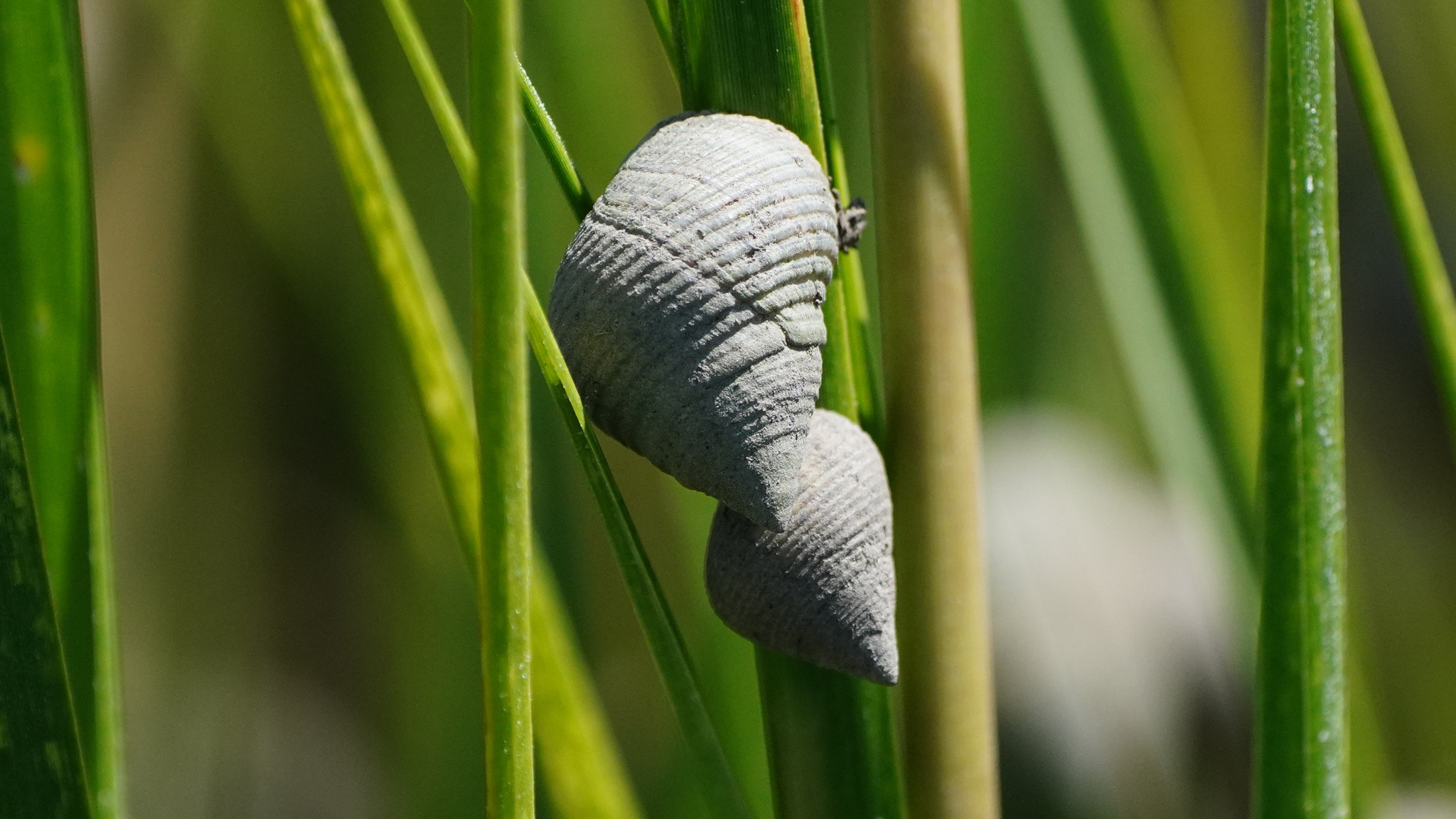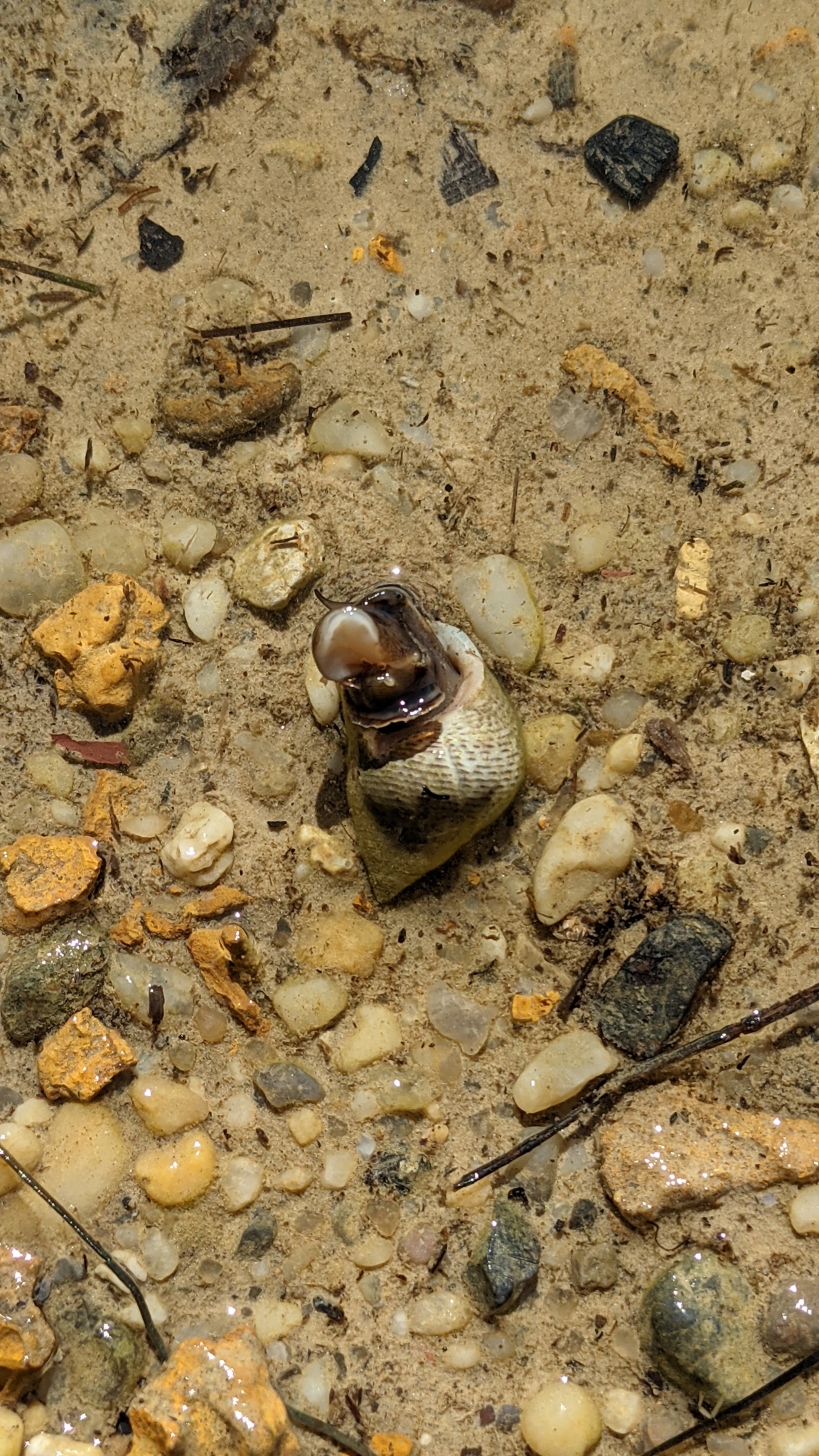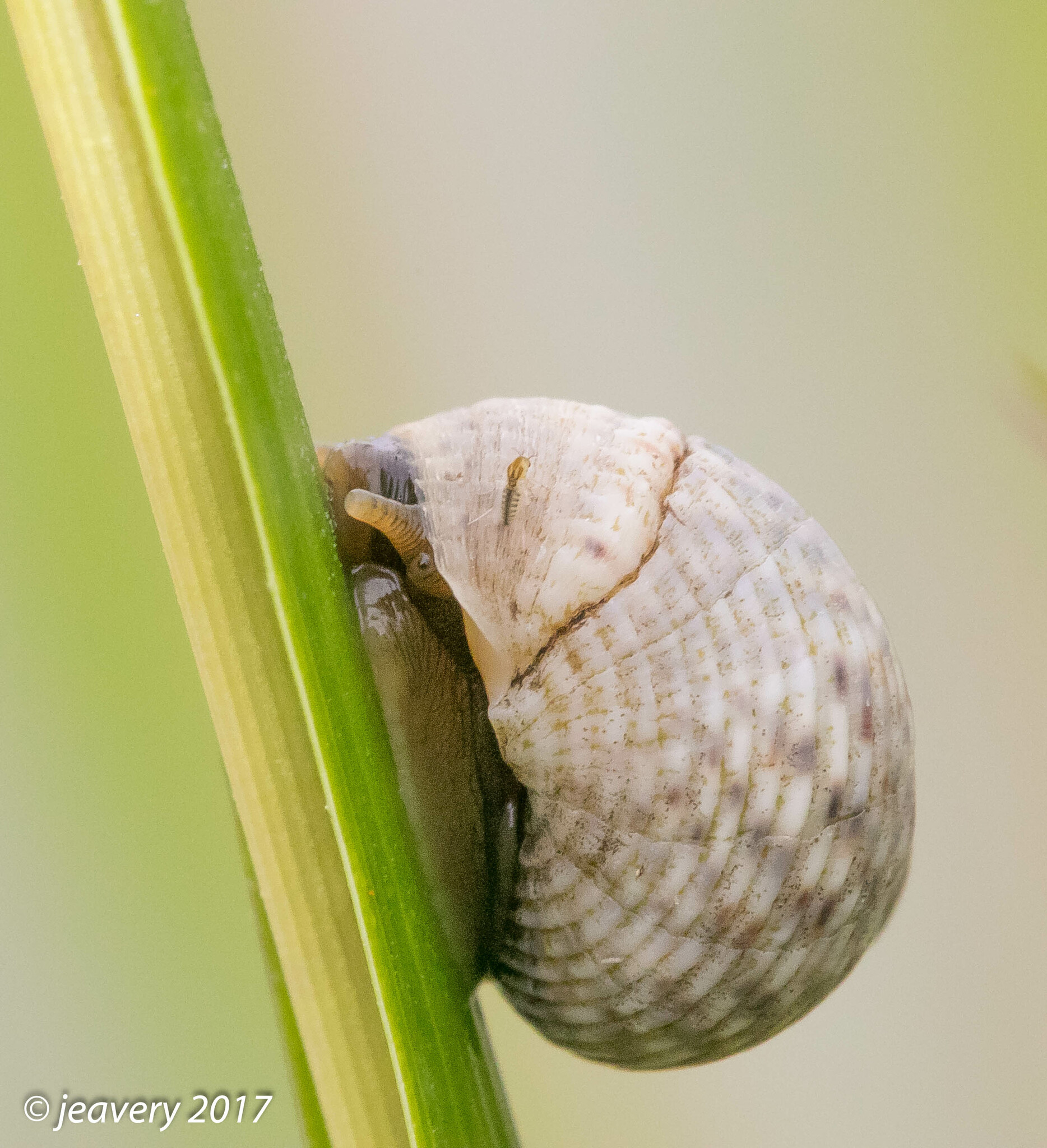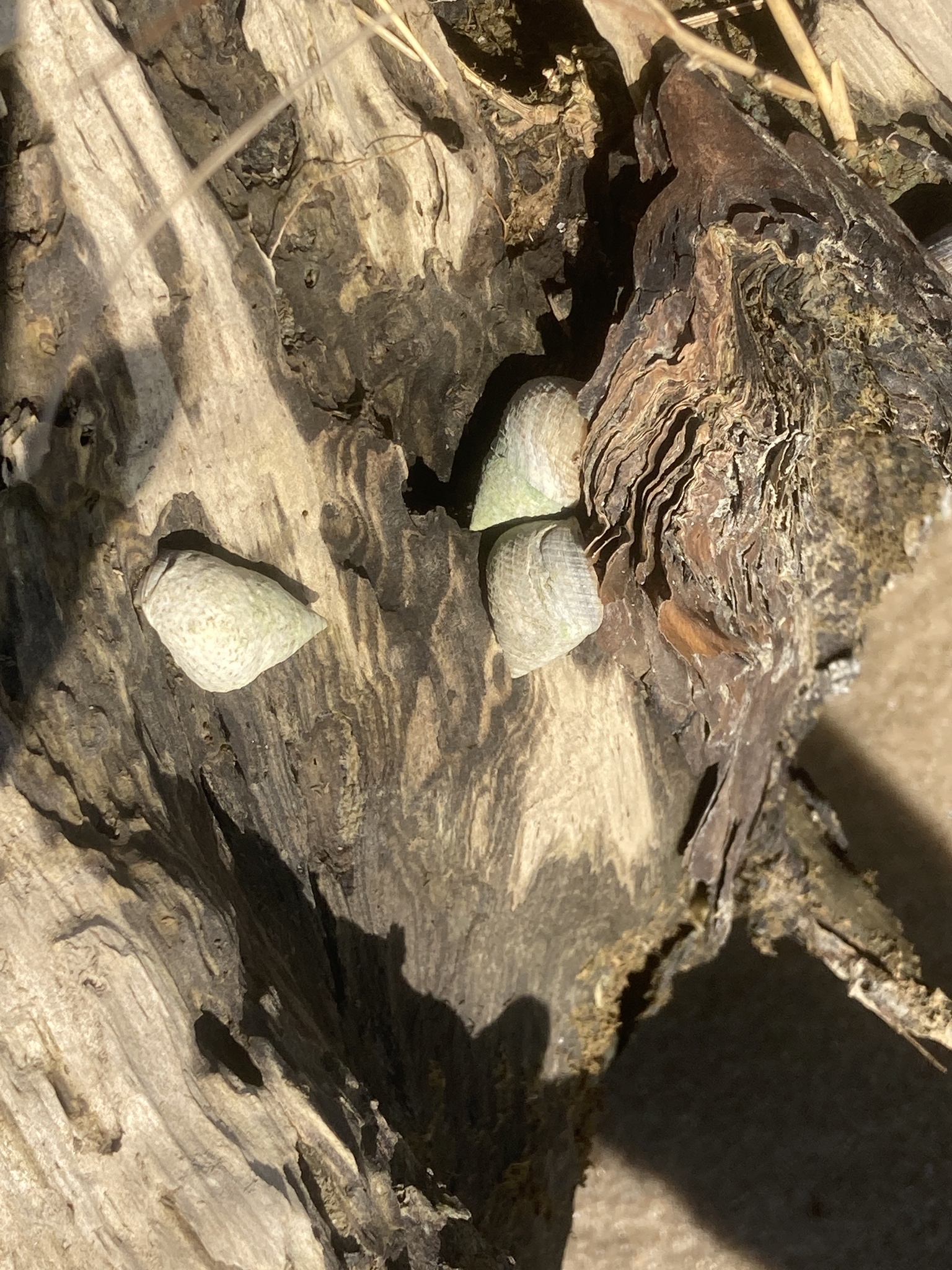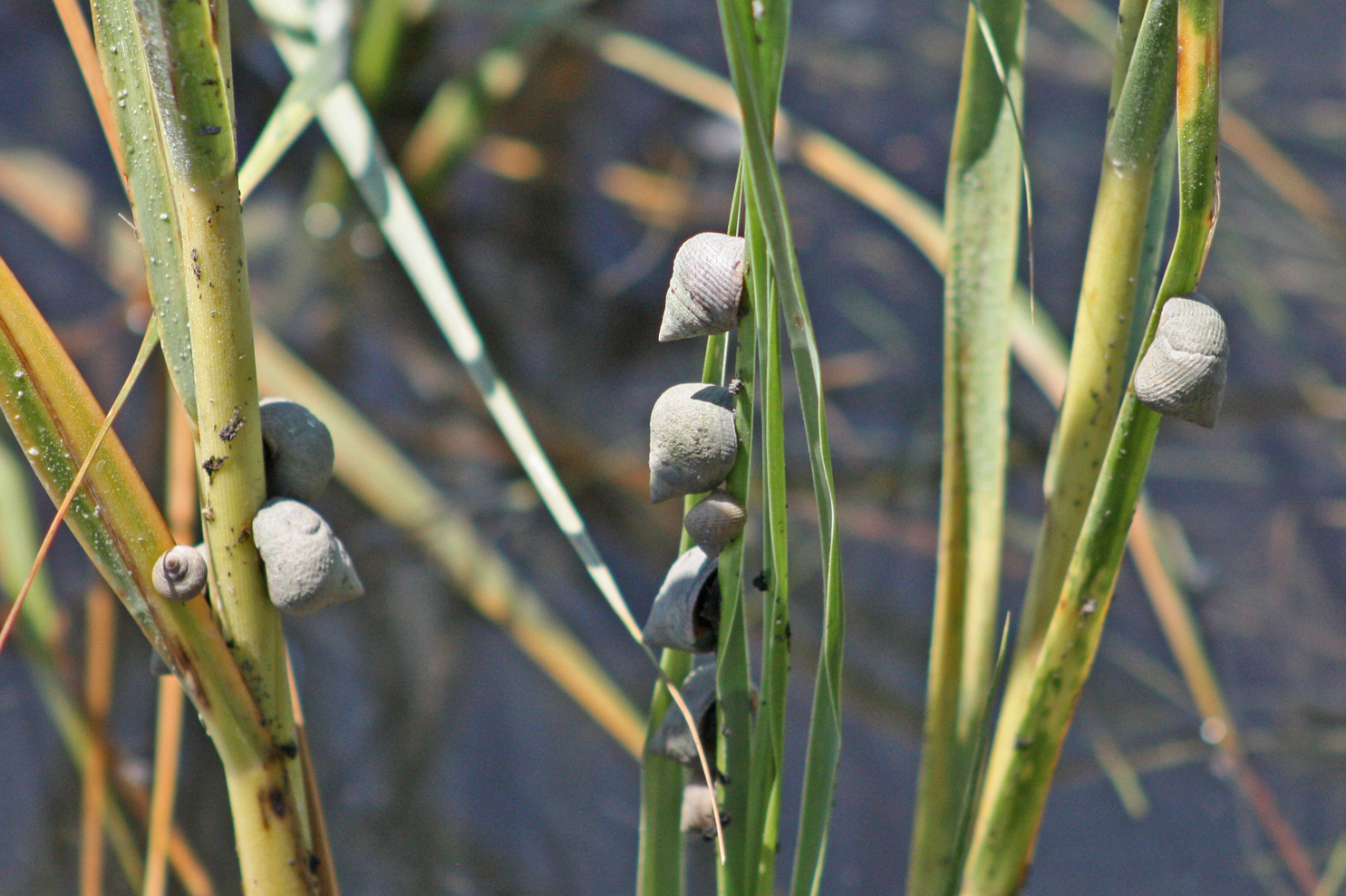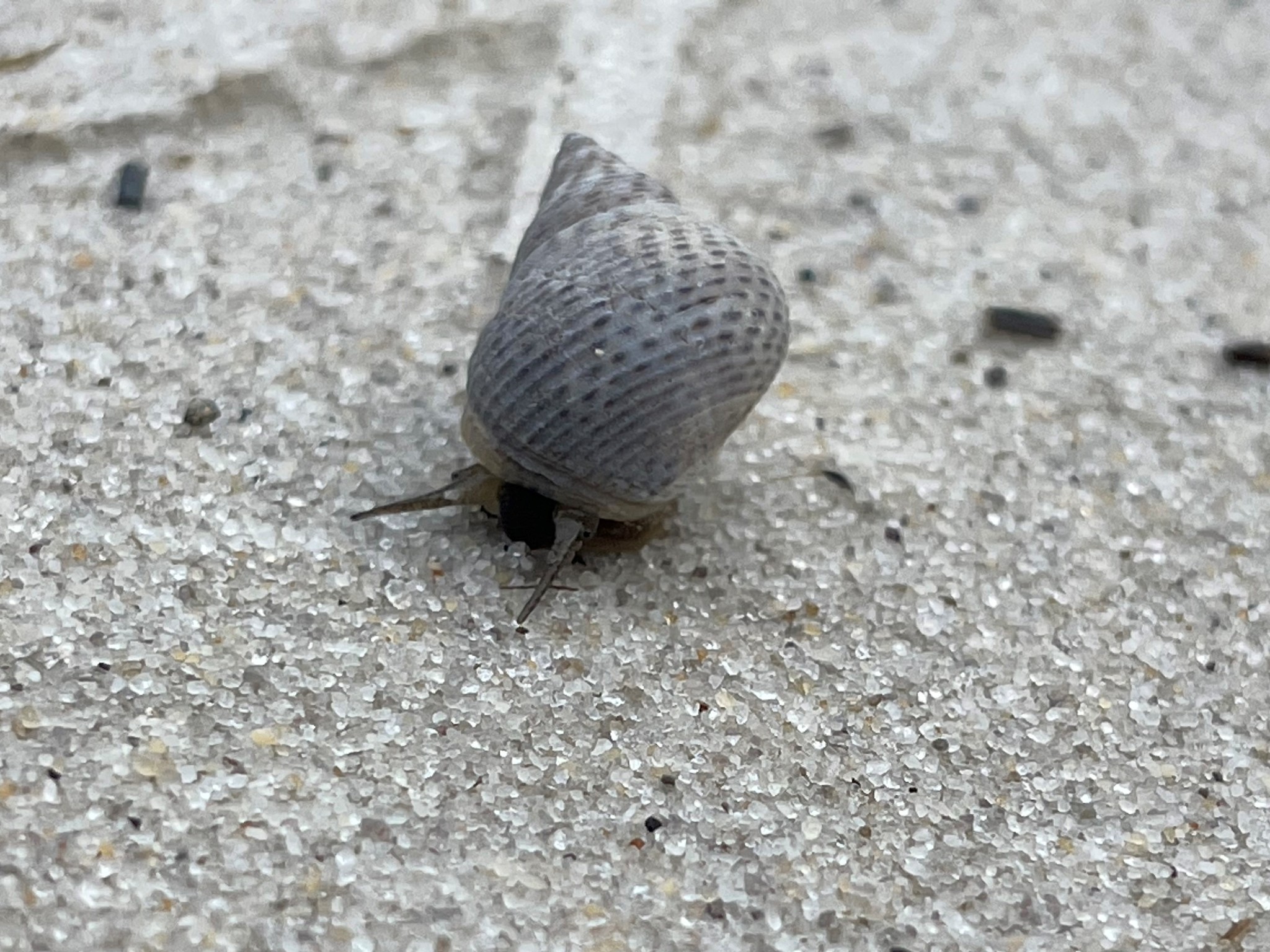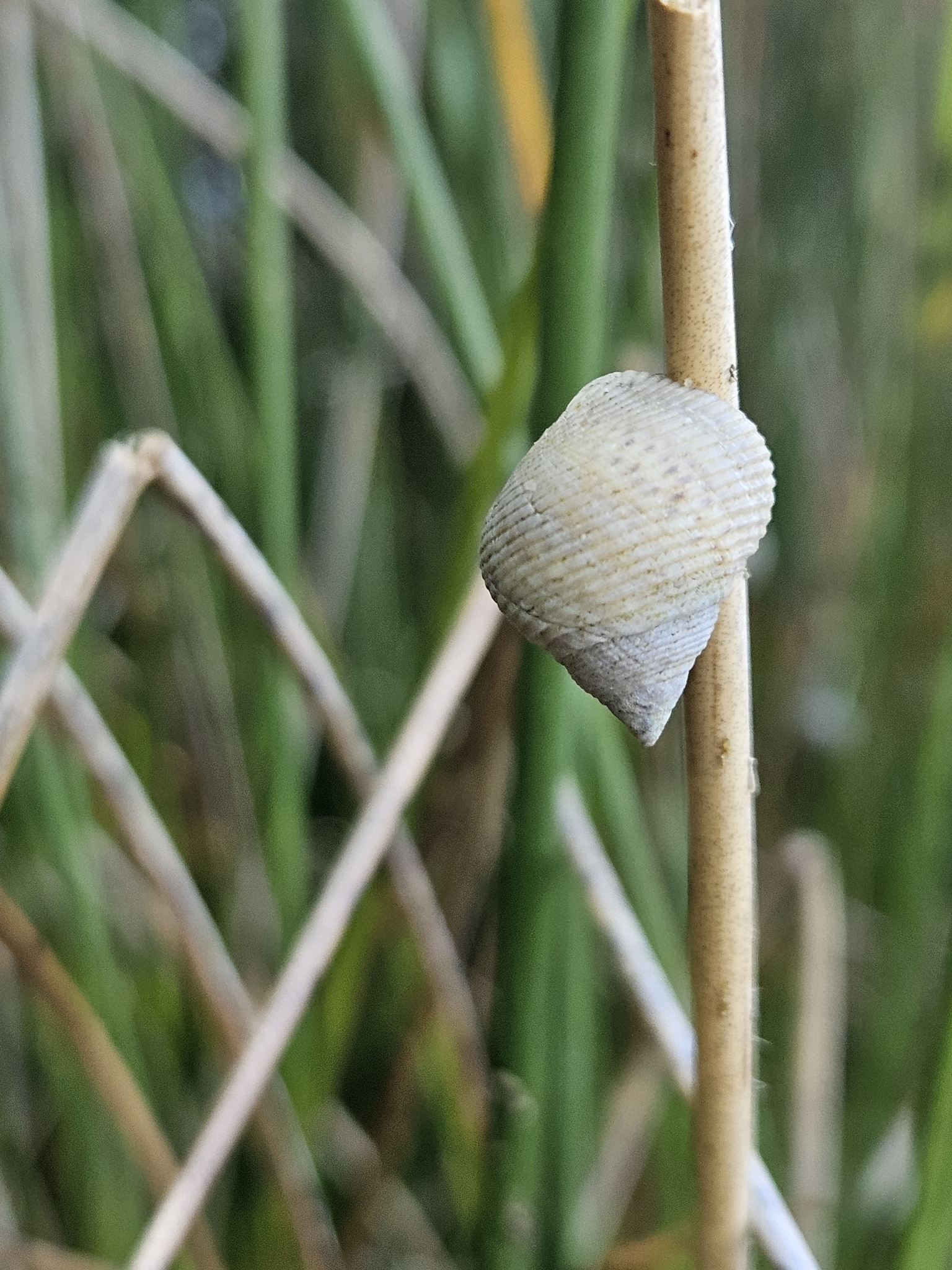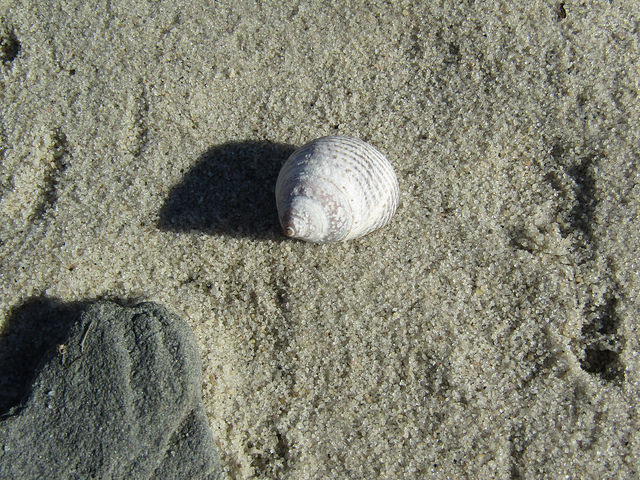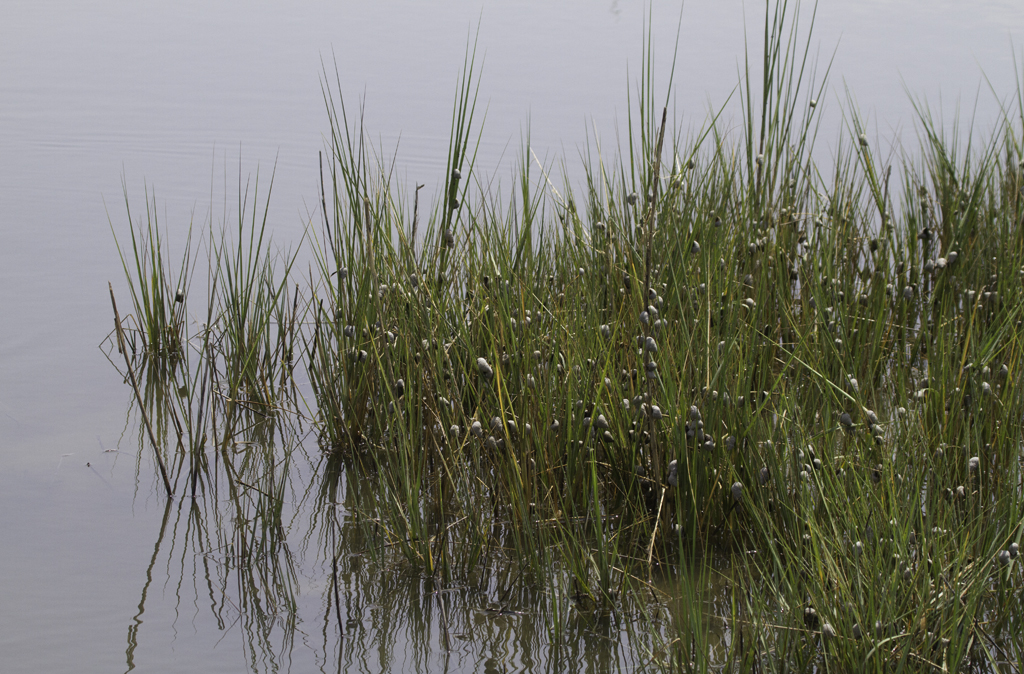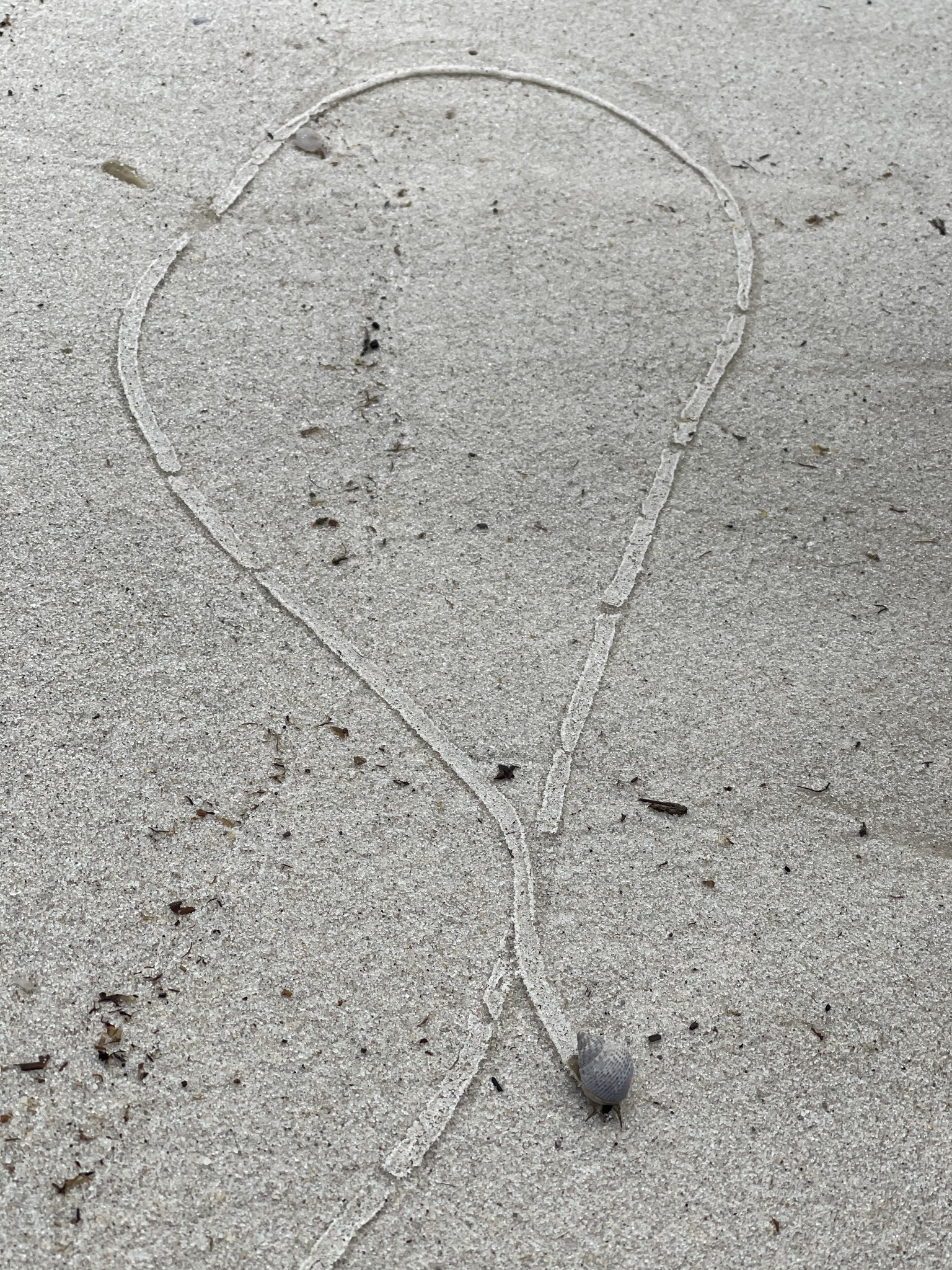Map Snapshot










190 Records
Status
Identifying Marsh Periwinkles along the shores of the Chesapeake Bay and its larger tributaries is easy as there are no other similar species. Things get trickier in the coastal marshes of Worcester County. The non-native Common Periwinkle (Littorina littorea) was found in Ocean City in 1959 and is now established along the Maryland coast.
Relationships
There is an important relationship between the Marsh Periwinkle and Smooth Cordgrass. According to the Chesapeake Bay Program, "These snails are known to practice 'fungiculture': by chewing holes in the cordgrass and spreading waste across the cuts, the marsh periwinkle can 'farm' fungus, their preferred food." Periwinkles are fungus farmers! That fungus farming is a well-developed low-level mutualism with the ascomycete Phaeosphaeria spartinicola.
Atlantic Blue Crab is a primary predator.
Seasonality Snapshot
Source: Wikipedia
| Littoraria irrorata | |
|---|---|
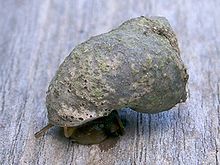
| |
| The shell of this Littoraria irrorata individual is covered in the lichen Pyrenocollema halodytes | |
| Scientific classification | |
| Domain: | Eukaryota |
| Kingdom: | Animalia |
| Phylum: | Mollusca |
| Class: | Gastropoda |
| Subclass: | Caenogastropoda |
| Order: | Littorinimorpha |
| Family: | Littorinidae |
| Genus: | Littoraria |
| Species: | L. irrorata
|
| Binomial name | |
| Littoraria irrorata | |
| Synonyms[3] | |
Littoraria irrorata, also known by the common name the marsh periwinkle, is a species of sea snail, a marine gastropod mollusk in the family Littorinidae.[3] The specific epithet irrorata means 'moistened' or 'dewy.'
This species occurs in salt marshes on the Atlantic coast and Gulf Coast of North America, from Massachusetts to Texas.
Some colonies of this species of snail are the only mollusks known to practice fungiculture.[4]
L. irrorata is an essential part of the salt marsh ecosystem. This is displayed in its strong relationship with Sporobolus alterniflorus, also known as Spartina alterniflora, a grass commonly found in abundance in salt marshes.[5]
Description
[edit]The maximum recorded shell length is 29.2 millimetres (1.15 in).[6] L. irrorata is extremely temperature tolerant. The snail has the ability to retract its foot into its shell when experiencing thermal stress which allows them to avoid water loss by evaporation and survive in high temperatures.[7]
Distribution
[edit]This species can be found along Ireland, the Northwest Atlantic Ocean and the Gulf of Mexico. Spatial distributions of L. irrorata in salt marshes likely depend on predation pressures and vary with geography.[5] It is possible that S. alterniflorus stem density plays a role in the local distribution of L. irrorata.[8]
Ecology
[edit]
Feeding habits
[edit]Littoraria irrorata feeds on fungi that it encourages to grow. It creates and maintains wounds on the grass, S. alterniflorus, which are then infected by fungi, probably of the Phaeosphaeria and Mycosphaerella genera. Such fungi are the preferred diet of the snail. L. irrorata also deposits faeces on the wounds that they create, which encourage the growth of the fungi because they are rich in nitrogen and fungal hyphae. Juvenile snails raised on uninfected leaves do not grow and are more likely to die, indicating the importance of the fungi in the diet of L. irrorata.[4] The diet of L. irrorata also consists of algal mats on the salt marsh floor, dead S. alterniflorus, live S. alterniflorus, and marsh sediment.[9] L. irrorata is capable of having a strong top-down control of S. alterniflorus production due to its grazing of the live shoots.[10]
Habitat
[edit]The minimum recorded depth for this species is 0 metres (0 ft); maximum recorded depth is 22 metres (72 ft).[6] L. irrorata can usually be found on the rootstock of S. alterniflorus and in some salt marshes on its dead, fallen leaves.[11] L. irrorata has also been observed to inhabit Sporobolus cynosuroides.[12] There were no significant differences in snail population density between S. alterniflorus and S. cynosuroides.[12] However, S. cynosuroides was observed to be a safer habitat due to its superior height.[12] The shell size of the snail has been found to increase with decreasing elevation in Virginia salt marshes but the exact opposite has been found in South Carolina and Florida salt marshes.[5]
Predation
[edit]Predators of L. irrorata include blue crabs, diamondback terrapins, clapper rail and raccoons.[13] Predator cues for L. irrorata can be water related as well as airborne.[14] It is likely that chemicals in the incoming tide cue the snails to climb S. alterniflorus. It is also possible that blue crabs give off some compound which is aerosolized and detected by L. irrorata.[14] L. irrorata responds quickest to chemicals released when the shells of other snails are broken.[15]
In order to avoid predation, L. irrorata has the ability increase the thickness of their shell ridge which in turn decreases the size of their aperture opening.[5] This makes it difficult for predators to remove them from their shell. This is an essential function to have as blue crabs are commonly seen chipping away at the shell ridge in order to feed on the snail.[5]
Another method L. irrorata uses to avoid predation is vertical climbing of the grass S. alterniflorus. The snails climb up the grass during high tide to avoid predation and descend during low tide to feed. This is a very effective defense against predators.[16]
Impacts of the Deepwater Horizon oil spill
[edit]
The Deepwater Horizon oil spill had major impacts on the productivity, population density, and growth of L. irrorata in salt marshes along the Gulf of Mexico and southeastern United States. Snail densities were reduced by 80-90% on the oil covered salt marsh edges and 50% in the marsh interior.[13] The major loss of adult snails resulted in a reduced mean snail size in salt marshes. It was originally projected that it would take about 3–5 years for the L. irrorata population density to recover from the oil spill.[13] However, snail populations still have not made a full recovery nine years after the oil spill. It is now projected that it could take one to two decades for L. irrorata populations to fully recover at heavily oiled sites.[17]
References
[edit]- ^ "Littoraria irrorata". NCBI taxonomy. Bethesda, MD: National Center for Biotechnology Information. Retrieved 29 September 2017.
Lineage( full ) cellular organisms; Eukaryota; Opisthokonta; Metazoa; Eumetazoa; Bilateria; Protostomia; Lophotrochozoa; Mollusca; Gastropoda; Caenogastropoda; Hypsogastropoda; Littorinimorpha; Littorinoidea; Littorinidae; Littoraria
- ^ Say T (24 July 1821). "An Account of some of the Marine Shells of the United States" (pdf). Journal of the Academy of Natural Sciences of Philadelphia. II (2): 239–240. ISSN 0885-3479. LCCN 12030018. OCLC 1460713. Retrieved 18 January 2018.
- ^ a b Reid DG (2011). "Littoraria irrorata (Say, 1822)". World Register of Marine Species. Retrieved 16 May 2011.
- ^ a b Silliman BR, Newell SY (December 2003). "Fungal farming in a snail". Proceedings of the National Academy of Sciences of the United States of America. 100 (26): 15643–8. Bibcode:2003PNAS..10015643S. doi:10.1073/pnas.2535227100. PMC 307621. PMID 14657360.
- ^ a b c d e Rietl AJ, Sorrentino MG, Roberts BJ (June 2018). "Spatial distribution and morphological responses to predation in the salt marsh periwinkle". Ecosphere. 9 (6): e02316. Bibcode:2018Ecosp...9E2316R. doi:10.1002/ecs2.2316.
- ^ a b Welch JJ (January 2010). "The "island rule" and deep-sea gastropods: re-examining the evidence". PLOS ONE. 5 (1): e8776. Bibcode:2010PLoSO...5.8776W. doi:10.1371/journal.pone.0008776. PMC 2808249. PMID 20098740.
- ^ Iacarella J, Helmuth B (December 2011). "Experiencing the salt marsh environment through the foot of Littoraria irrorata: Behavioral responses to thermal and desiccation stresses". Journal of Experimental Marine Biology and Ecology. 409 (1–2): 143–153. doi:10.1016/j.jembe.2011.08.011.
- ^ Kiehn WM, Morris JT (September 2009). "Relationships between Spartina alterniflora and Littoraria irrorata in a South Carolina salt marsh". Wetlands. 29 (3): 818–825. Bibcode:2009Wetl...29..818K. doi:10.1672/08-178.1. ISSN 0277-5212. S2CID 23611399.
- ^ Alexander S (1979-01-01). "Diet of the Periwinkle Littorina irrorata in a Louisiana Salt Marsh". Gulf and Caribbean Research. 6 (3): 293–295. doi:10.18785/grr.0603.11. ISSN 1528-0470.
- ^ Silliman BR, Zieman JC (October 2001). "Top-Down Control of Spartina alterniflora Production by Periwinkle Grazing in a Virginia Salt Marsh". Ecology. 82 (10): 2830–2845. Bibcode:2001Ecol...82.2830S. doi:10.2307/2679964. JSTOR 2679964.
- ^ Crist RW, Banta WC (1983-01-01). "Distribution of the Marsh Periwinkle Littorina irrorata (Say) in a Virginia Salt Marsh". Gulf Research Reports. 7. doi:10.18785/grr.0703.04. ISSN 0072-9027.
- ^ a b c Failon CM, Wittyngham SS, Johnson DS (October 2020). "Ecological Associations of Littoraria irrorata with Spartina cynosuroides and Spartina alterniflora". Wetlands. 40 (5): 1317–1325. Bibcode:2020Wetl...40.1317F. doi:10.1007/s13157-020-01306-4. ISSN 0277-5212. S2CID 219947420.
- ^ a b c Zengel S, Montague CL, Pennings SC, Powers SP, Steinhoff M, Fricano G, et al. (January 2016). "Impacts of the Deepwater Horizon Oil Spill on Salt Marsh Periwinkles (Littoraria irrorata)". Environmental Science & Technology. 50 (2): 643–52. Bibcode:2016EnST...50..643Z. doi:10.1021/acs.est.5b04371. PMID 26713547.
- ^ a b Carroll JM, Church MB, Finelli CM (2018-10-01). "Periwinkle climbing response to water- and airbone predator chemical cues may depend on home-marsh geography". PeerJ. 6: e5744. doi:10.7717/peerj.5744. PMC 6171496. PMID 30294513.
- ^ Wollerman L, Duva M, Ferrier MD (September 2003). "Responses of Littoraria irrorata say (Mollusca: Gastropoda) to water-borne chemicals: A comparison of chemical sources and orientation mechanisms". Marine and Freshwater Behaviour and Physiology. 36 (3): 129–142. Bibcode:2003MFBP...36..129W. doi:10.1080/10236240310001603756. ISSN 1023-6244. S2CID 84921653.
- ^ Vaughn CC, Fisher FM (November 1988). "Vertical migration as a refuge from predation in intertidal marsh snails: A field test". Journal of Experimental Marine Biology and Ecology. 123 (2): 163–176. doi:10.1016/0022-0981(88)90167-0.
- ^ Deis DR, Fleeger JW, Johnson DS, Mendelssohn IA, Lin Q, Graham SA, et al. (November 2020). "Recovery of the salt marsh periwinkle (Littoraria irrorata) 9 years after the Deepwater Horizon oil spill: Size matters". Marine Pollution Bulletin. 160: 111581. Bibcode:2020MarPB.16011581D. doi:10.1016/j.marpolbul.2020.111581. PMID 32890962. S2CID 221511569.
Further reading
[edit]- Reid DG (1986). The littorinid molluscs of mangrove forests in the Indo-Pacific region. London: British Museum (Natural History).
- Reid DG (1989a). "The comparative morphology, phylogeny and evolution of the gastropod family Littorinidae". Philosophical Transactions of the Royal Society of London, Series B. 324 (1220): 1–110. Bibcode:1989RSPTB.324....1R. doi:10.1098/rstb.1989.0040.
- Reid DG, Dyal P, Williams ST (April 2010). "Global diversification of mangrove fauna: a molecular phylogeny of Littoraria (Gastropoda: Littorinidae)". Molecular Phylogenetics and Evolution. 55 (1): 185–201. doi:10.1016/j.ympev.2009.09.036. PMID 19808097.
- Rosenberg G, Moretzsohn F, García EF (2009). "Gastropoda (Mollusca) of the Gulf of Mexico". In Felder DL, Camp DK (eds.). Gulf of Mexico–Origins, Waters, and Biota. Biodiversity. College Station, Texas: Texas A&M Press. pp. 579–699.
External links
[edit]- Malacolog info
 Media related to Littoraria irrorata at Wikimedia Commons
Media related to Littoraria irrorata at Wikimedia Commons Data related to Littoraria irrorata at Wikispecies
Data related to Littoraria irrorata at Wikispecies

